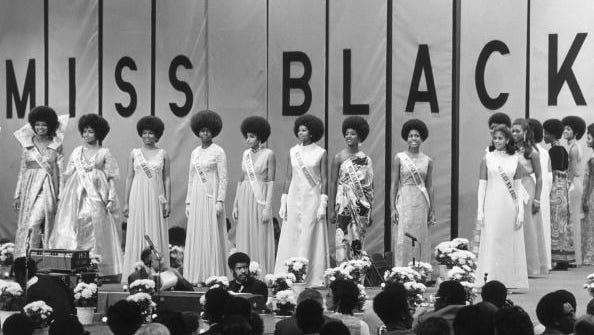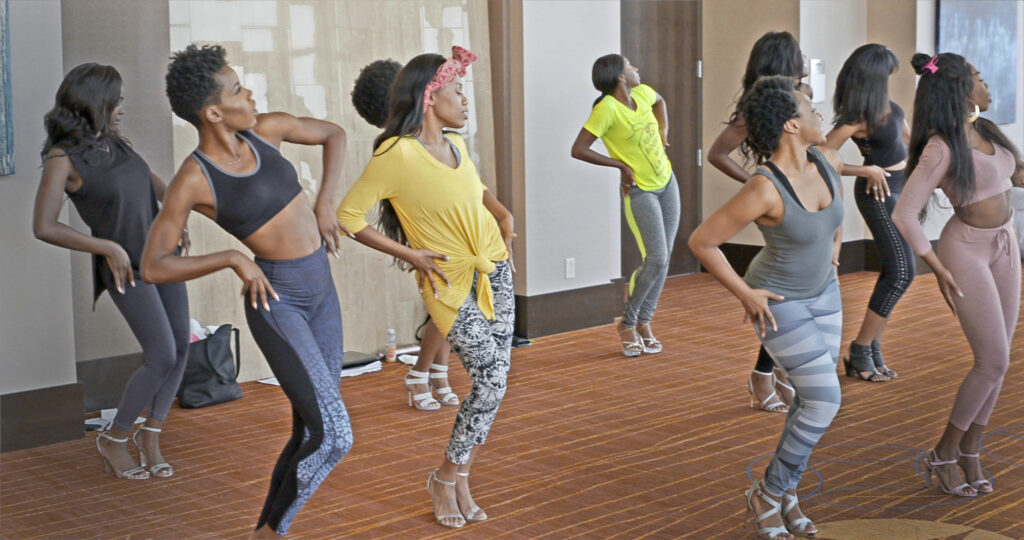Subjects of Desire is a powerful project that transports viewers from the past to the present by examining and deconstructing the prejudices that have been imposed on Black women for decades…
By Blessing Chinwendu Nwankwo
It’s becoming a bit disturbing that the Kardashian women won’t stop cosplaying Black women. On March 5, 2020, Kylie, the youngest of the Kardashian-Jenner clan, took to Twitter and Instagram to share a few photographs from her latest photo session. Styled in a hooded neon green leopard gown from Tom Ford, and her new bronde hair styled in loose curls, Kylie made a post captioned, “Giving you baby mama drama honey.” Kylie looked noticeably darker and generally quite different, a fact that raised eyebrows. Some tweeps believed she was only blackfishing, and others pointed out that she looked a lot like Beyoncé in the picture. In 2018, Kim Kardashian was criticised for making Fulani braids and calling them “Bo braids,” crediting the style to American actress, Bo Derek. The attempt of the Kardashians seem, thus, to work towards “unblacking.”
Cultural appropriation is the inappropriate or unacknowledged adoption of an element or elements of one culture or identity by members of another culture or identity. While it may seem that it is the Blacks in the global society always complaining about it, we see cultural appropriation everywhere: whether someone adopts a hairstyle, a piece of clothing, or a way of speaking. It happens every day, often unintentionally, whether online, through the media and national news, or on college campuses. Cultural appropriation raises difficult questions about the overlapping and power dynamics of race, politics, society, and individuality, elements of which may recede into a grey area, leaving social media users wondering what is the right or wrong approach to content creation, what is sensitive or insensitive, as we engage audiences. Cultural appropriation is further described as the wrong use of culture for the intent of seeking creative inspiration, such as when a member of a dominant group dresses up as a member of a minority group for a costume party or a musical performance; a good example is Simon and Jane Pilkings’ party costume in Elesin Oba: the King’s Horseman. Conceptually, cultural appropriation has been viewed asa cultural offence.
Prior to the repeal of Army Regulation 670-1, most uniformed working class black women were prohibited from wearing natural hairstyles, such as twists, dreadlocks, Afros, and braids. This was because the regulation classified natural hair as “matted” and “unkempt.” Hence the reason black women were chastised for their cultural expression, as with the case of Rogers vs. American Airlines Inc. cited in Subjects of Desire. However, the general view portrayed by the media is that some races are celebrated for surgically getting the same features that make a black lady “too black.”
(Read also: Hair Fetish Has Come a Longer Way Than We Know)
Jennifer Holness’s Subjects of Desire was originally released on March 17th, 2021, and recently on Showmax. It explores the cultural shift in North American beauty standards, the influence of black aesthetics on global beauty standards, and how such standards penalise black women. It is a compilation of emotionally-charged visual stories and experiences of black women that seek to legitimise their pains and feelings in contrast to stereotyped narratives that portray them as angry, rebellious, and bitter. The documentary delves into black beauty philosophy, black beauty discrimination, the black revolution, and the role of the media in promoting racial animosity.

Subjects of Desire is told through the eyes of women who aren’t afraid of challenging conventional beauty standards. The documentary features the likes of the four-time Grammy winner, India Arie; Canadian Queen of R&B, Jully Black; former Miss Black America winners, activist Brittany Lee Lewis, and tech entrepreneur, Ryann Richardson. It shines a much-needed light on their challenges, ambitions, dreams, anxieties, oddities, and the shared humanity that makes them human like everyone else. But will it be enough to transform society’s opinion of Blacks and reduce prejudice in the Western world? There have been significant adjustments and changes to the inclusion of Blacks in the Western world since the Black Power Revolution in 1970. Still, it has been insufficient in completely eradicating racism.
(Read also: Is Africa Commemorating Its Heroes Enough?)
Blacks are born into a generational requirement to be strong. The black girl is programmed from birth to explain her existence. Nonetheless, she is made to understand that she does not meet or fit the established and accepted beauty standards. These are the bases of my question. Does being black make me any less pretty? What exactly does it mean to be black? Is it the dark complexion, the afro hair, or the full lips? Or is it the thick thighs that come with the sometimes unusually big bum. The simple fact is that these are all characteristics that should help in recognising a black person; yet, because the entire world has jumped on those features and interpreted them to be trends, identifying a black person has become a more dreadful process.
Early in Subjects of Desire, we are reminded of a watershed event in Black history, when five of the world’s most prestigious beauty pageants were won by Black women: Miss World, Miss Teen USA, Miss America, Miss USA, and Miss Universe. It served as a symbol of shifting attitudes in an industry where Black people were historically excluded outright. While it took decades for Black women to be explicitly recognised as attractive, pageants such as Miss Black America provided a platform to challenge the status quo. As Holness explores the impact of America’s oppressive past on Black women’s perceptions, she structures her incisive documentary around the Miss Black America pageant and its 2018 contestants, demonstrating the perpetual relevance of such initiatives that uplift the black woman. Subjects of Desire goes on to explore the history of the Miss Black America beauty pageant, established and organised by J. Morris Anderson and Brenda Cozart in 1968. The pageant was created in protest against the Miss America beauty pageant as it originally excluded Black women contestants. Stating what she loved about the pageant, the Former Miss Black America, Brittany Lewis, said, “It creates a space for us to continue to celebrate Black beauty, Black excellence, and the Black experience unapologetically.”
Malcolm X’s philosophy features heavily in Subjects of Desire. It is audibly echoed and printed on the screen. Holness successfully establishes a connection between standards of beauty, and social justice. From the earliest “beast-like” depictions of Black women to modern rejections of Black women’s features as “too ethnic,” she contextualises their rape, murder, and prejudice through direct, yet incisive, observations.
The documentary moves back and forth in time, examining the positive and negative images of Black women in the media and existing impact. Within the opening few minutes of the film, Subjects of Desire makes a profound message about targeted hate, abuse, and other controversial themes such as appropriation and blackfishing. This is accomplished by displaying multiple headlines on occurrences involving Black women, all while playing a clip from X’s Who Taught You To Hate Yourself speech. The initial few minutes of the film are crucial in setting the tone throughout the documentary. As the film makes obvious, this isn’t merely a documentary about the public acceptance of Black women’s characteristics as beautiful. It is also about analysing the concerns of racism, stereotypes, and appropriation that are unique to Black women.

The documentary’s strongest aspect is how it examines and deconstructs three stereotypes derived from slavery and have been used to define Black women in media for years: the Mammy, the Jezebel, and the Sapphire. The Mammy stereotype portrays Black women as caretakers and maids who exist solely to nurture, serve, and solve problems for white people. The Jezebel is a stereotype that portrays Black women as oversexualised and exoticised individuals who are always looking for sex. Sapphire is the perennially angry Black lady stereotype.
Subjects of Desire analyses how these stereotypes have shaped how Black women are viewed by others, as well as the impacts they have had through time, and how they are used today. For example, the Sapphire, also known as the “Angry Black Woman,” is a popular stereotype of Black women in films such as Amos n’ Andy, and Waiting to Exhale. Holness’ documentary analyses how these fictional stereotypes have influenced how people see Black women. Their rage now portrays them as cruel, domineering, and violent. As Dr. Cheryl Thompson says on the stereotype’s impact on society’s impression of Black women, “The public image of Black womanhood is we’ve got it together, we’re strong, or we’re strong and angry, we’re always aggressive.”
The breakdown and overview of these stereotypes are provocative. On many occasions while watching this documentary, I paused to reflect on which of those stereotypes I have been labelled as, and how it shaped people’s perspective of me. Now that we know the extensive history behind them, it is highly informative to learn how they were designed to ridicule, and unfairly downplay the Black woman’s experience for decades. Our individuality, emotions, and even our ability to experience sexual urges and feelings are all affected. The documentary surely makes the audience think about how much our perception is influenced by racist stereotypes.
Holness then throws a bombshell with the inclusion of Rachel Dolezal in the film. To give a basic overview, Dolezal is synonymous with appropriation. She still identifies as black despite being revealed on national television by her birth parents years ago for blackfishing. After listening to her views, I can now understand the filmmakers’ decision to incorporate Dolezal as a part of this production. Giving her a chance to speak, we may see Dolezal as a prime example of one who appropriates Black features out of genuine admiration. Despite being outed, mocked, and humiliated as a white lady for years, she still identifies as Black.
The decision to interview Dolezal makes more sense as the documentary delves deeper into the problems of appropriation and blackfishing. They are examples made on the problematic behaviours among white men and non-black women, notably among celebrities such as the Kardashians, and Instagram influencers. The documentary touches on how these behaviours are not about appreciating traits, but rather about reducing Blackness and its characteristics to an aesthetic.
Subjects of Desire delves into these problems in-depth, gathering numerous perspectives from interviewees on the rise in appropriation and blackfishing as white and non-black people consider them “trendy” now. Miss Black America 2018, Ryann Richardson, made a very poignant speech on the subject. She said, “For some reason, greater American culture has a fascination with taking whatever has been done by Black people for years, and years, and years and putting it on a white girl and call it the new trend.”
Overall, the cultural impact of this documentary is immeasurable. Subjects of Desire is a powerful project that transports viewers from the past to the present by examining and deconstructing the prejudices that have been imposed on Black women for decades. The documentary questions what we have been told or taught to believe about race, power, and beauty. It is unafraid to confront difficult problems such as the acceptance of beauty standards in the Black community. Subjects of Desire captures the joy, solidarity, and empowerment of black women in a relatable and inspiring way.

More importantly, Holness does not avoid the more difficult questions of appropriation and colourism, especially between black men and their preference to white women or light skinned black women. Indeed, conversations about hair are particularly helpful in understanding cultural transitions in Black aesthetic sensibility. Subjects of Desire makes one thing vividly evident throughout: even when the world refused to acknowledge it, black has always been beautiful.
Rating: 3.5/5
(Watch Subjects of Desire on Showmax)
Blessing Chinwendu Nwankwo, a film critic, beautician, and accountant, currently writes from Lagos State, Nigeria. Connect with her on Twitter at @Glowup_by_Bee and on Instagram at @blackgirl_bee.




